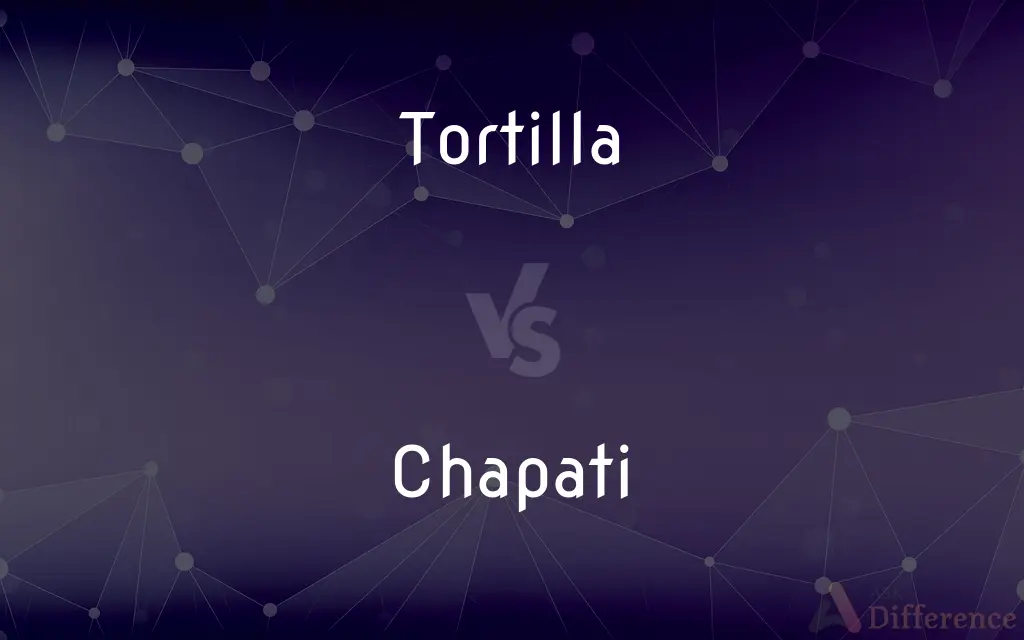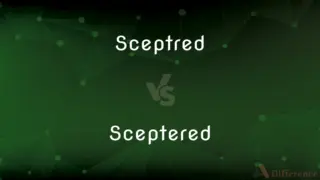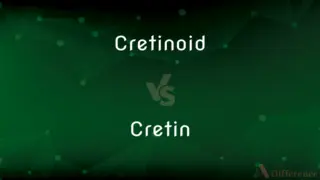Tortilla vs. Chapati — What's the Difference?
Edited by Tayyaba Rehman — By Fiza Rafique — Updated on October 5, 2023
A tortilla is a flatbread primarily from Mexico, often made from corn or wheat, while a chapati, an Indian flatbread, is typically made from whole wheat flour and roasted on a skillet.

Difference Between Tortilla and Chapati
Table of Contents
ADVERTISEMENT
Key Differences
Tortillas are a staple in Mexican and Central American cuisines, with roots tracing back to ancient civilizations in the region. Chapatis, on the other hand, are integral to Indian, Pakistani, and some East African cuisines.
While both are flatbreads, tortillas are often made using either cornmeal (for corn tortillas) or refined white flour (for flour tortillas). Chapatis are traditionally made from whole wheat flour, known as 'atta' in the Indian subcontinent.
Tortillas, especially corn ones, are often cooked on a griddle or cast-iron skillet, while chapatis are cooked on a flat skillet called a 'tawa' and are sometimes finished over an open flame to puff them up.
Tortillas, particularly corn tortillas, have a unique taste attributed to the cornmeal. Chapatis have a more neutral taste and are softer, with layers that can be separated.
Tortillas are versatile and are used as wraps for tacos, enchiladas, and burritos, among others. Chapatis are usually served with vegetables, curries, and other accompaniments, and they're often used to scoop up food.
ADVERTISEMENT
Comparison Chart
Origin
Mexico and Central America
Indian subcontinent
Main Ingredient
Cornmeal or refined white flour
Whole wheat flour (atta)
Cooking Method
Griddle or cast-iron skillet
Flat skillet ('tawa') and sometimes over open flame
Texture
Depends on type; can be soft or slightly crispy
Soft, with separable layers
Uses
Tacos, burritos, enchiladas
Accompanies curries, vegetables, used to scoop food
Compare with Definitions
Tortilla
A foundational element for dishes like tacos, quesadillas, and enchiladas.
She made a delicious breakfast tortilla with scrambled eggs and salsa.
Chapati
A bread that is sometimes layered and can be spread with ghee or butter.
He spread some clarified butter on the hot chapati, making it even more delicious.
Tortilla
A versatile flatbread pivotal in Mexican cuisine.
For dinner, we had tortilla soup with fresh corn tortillas on the side.
Chapati
A round flatbread from the Indian subcontinent made of whole wheat flour.
I enjoyed the curry with a warm chapati on the side.
Tortilla
A disc-shaped bread that can be filled or topped with various ingredients.
I spread some guacamole on the tortilla before adding the grilled chicken.
Chapati
A staple in Indian cuisine, used to scoop up curries or vegetables.
For lunch, we had spinach curry and freshly made chapatis.
Tortilla
A thin, flat pancake made from cornmeal or flour, used in Mexican dishes.
I wrapped the beef and cheese in a tortilla to make a burrito.
Chapati
An unleavened bread that's often served with Indian dishes.
She rolled the chapati perfectly, and it puffed up beautifully on the skillet.
Tortilla
A bread that, when made from corn, is gluten-free and essential for many Mexican dishes.
As he was gluten-intolerant, he opted for corn tortillas instead of flour ones.
Chapati
A soft Indian bread that pairs well with both vegetarian and non-vegetarian dishes.
The spicy mutton curry was balanced out by the mild taste of the chapati.
Tortilla
A tortilla (, Spanish: [toɾˈtiʎa]) is a thin, flat, circular unleavened flatbread originally made from maize hominy meal, and now also from wheat flour. The Aztecs and other Nahuatl speakers called tortillas tlaxcalli ([t͡ɬaʃˈkalli]).
Chapati
Chapati (alternatively spelled chapatti, chappati, chapathi, or chappathi; pronounced as IAST: capātī, capāṭī, cāpāṭi), also known as roti, rotli, safati, shabaati, phulka and (in the Maldives) roshi, is an unleavened flatbread originating from the Indian subcontinent and staple in India, Nepal, Bangladesh, Pakistan, Sri Lanka, East Africa, Arabian Peninsula and the Caribbean. Chapatis are made of whole-wheat flour known as atta, mixed into dough with water, oil and optional salt in a mixing utensil called a parat, and are cooked on a tava (flat skillet).It is a common staple in the Indian subcontinent as well as amongst expatriates from the Indian subcontinent throughout the world.
Tortilla
A thin disk of unleavened bread made from masa or wheat flour and baked on a hot surface.
Chapati
A flat, unleavened, disk-shaped bread of northern India, made of wheat flour, water, and salt. Also called roti.
Tortilla
(Mexican cuisine) A flat round bread made out of cornmeal or flour.
Chapati
A flat, unleavened bread from northern India and Pakistan.
Tortilla
(Spanish cuisine) Spanish omelette; an omelette containing potatoes and onions.
Chapati
A flat pancakelike bread cooked on a griddle, originating in India.
Tortilla
An unleavened cake, as of maize flour, baked on a heated iron or stone.
Chapati
Flat pancake-like bread cooked on a griddle
Tortilla
Thin unleavened pancake made from cornmeal or wheat flour
Common Curiosities
What's the main ingredient in chapatis?
Chapatis are primarily made from whole wheat flour, known as 'atta'.
Are tortillas always made from corn?
No, tortillas can be made from either corn or wheat flour.
Can chapatis be used as a substitute for tortillas in recipes?
They can be, though they offer a different texture and flavor than traditional tortillas.
Which is healthier: tortilla or chapati?
Chapatis, made from whole wheat, typically have more fiber. However, nutritional value can vary based on ingredients and preparation.
Are tortillas and chapatis the same thing?
No, while both are flatbreads, tortillas originate from Mexico, and chapatis are from the Indian subcontinent.
Why do chapatis sometimes puff up when cooked?
The trapped steam during cooking causes the layers of the chapati to separate, making it puff up.
Are corn tortillas gluten-free?
Yes, corn tortillas are naturally gluten-free.
How do you keep tortillas soft?
Storing them in a sealed container or cloth keeps them soft. Warming them before serving also helps.
Is there a gluten-free version of chapati?
Yes, gluten-free chapatis can be made using alternative flours like chickpea flour.
Can you store chapatis and tortillas for later use?
Both can be stored, but they're best consumed fresh. If stored, it's ideal to reheat before eating.
Are tortillas and chapatis eaten worldwide?
Yes, while they have regional origins, both have become popular worldwide due to the spread of their respective cuisines.
Can tortillas be used in Indian cuisine?
Yes, though they'll provide a different flavor and texture than traditional chapatis.
How are tortillas used in Mexican cuisine?
Tortillas are versatile and can be used for tacos, burritos, enchiladas, and more.
What do you typically eat with chapatis?
Chapatis are usually paired with curries, vegetables, pickles, and yogurt.
Is chapati similar to other Indian bread like naan or paratha?
While they're all Indian breads, each has distinct ingredients, preparation methods, and textures.
Share Your Discovery

Previous Comparison
Sceptred vs. Sceptered
Next Comparison
Cretinoid vs. CretinAuthor Spotlight
Written by
Fiza RafiqueFiza Rafique is a skilled content writer at AskDifference.com, where she meticulously refines and enhances written pieces. Drawing from her vast editorial expertise, Fiza ensures clarity, accuracy, and precision in every article. Passionate about language, she continually seeks to elevate the quality of content for readers worldwide.
Edited by
Tayyaba RehmanTayyaba Rehman is a distinguished writer, currently serving as a primary contributor to askdifference.com. As a researcher in semantics and etymology, Tayyaba's passion for the complexity of languages and their distinctions has found a perfect home on the platform. Tayyaba delves into the intricacies of language, distinguishing between commonly confused words and phrases, thereby providing clarity for readers worldwide.















































